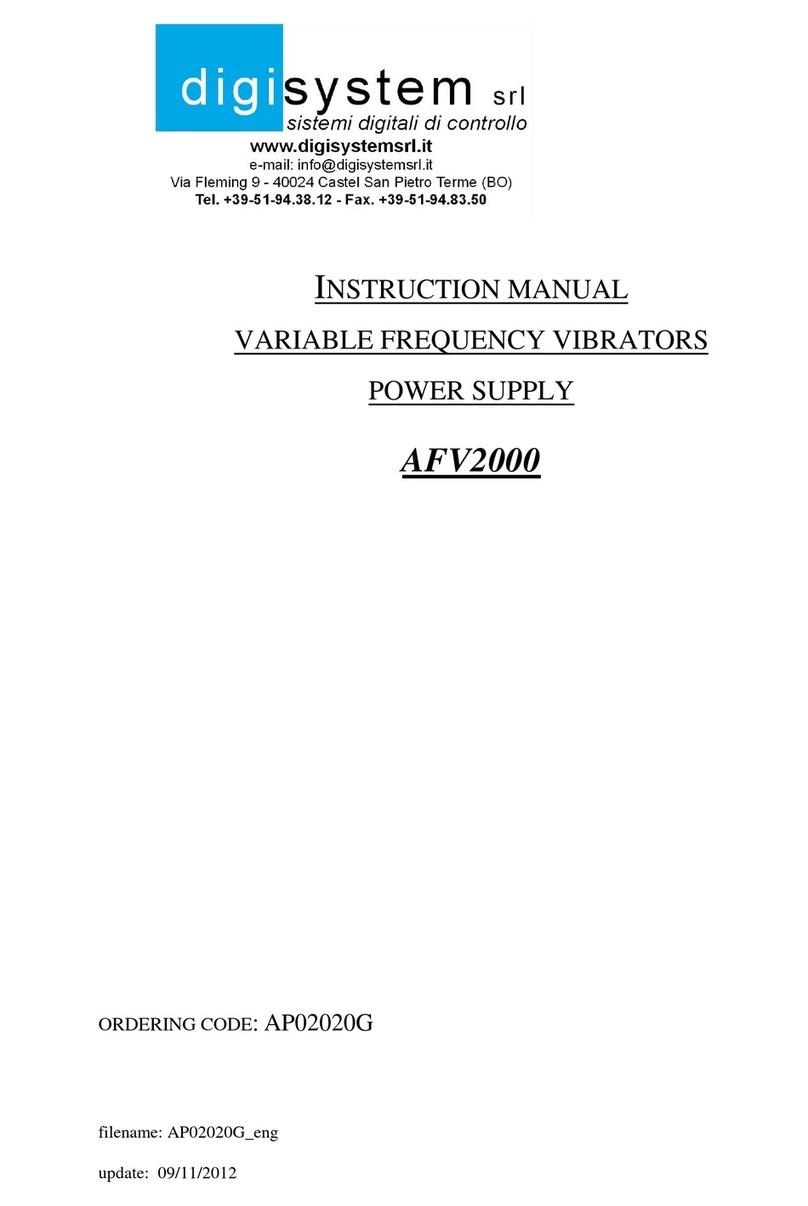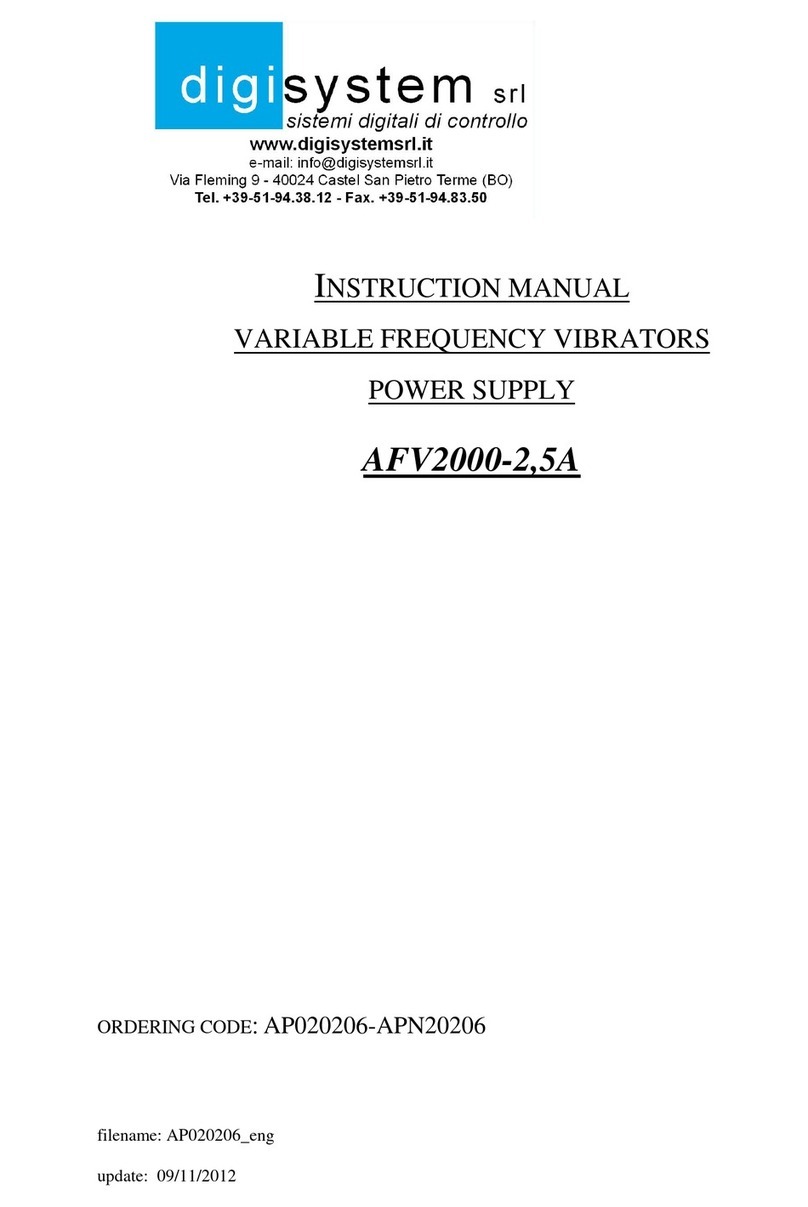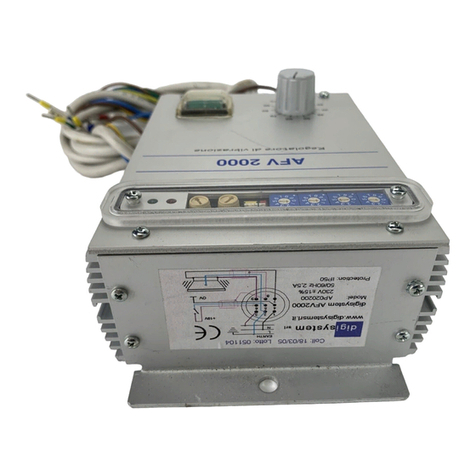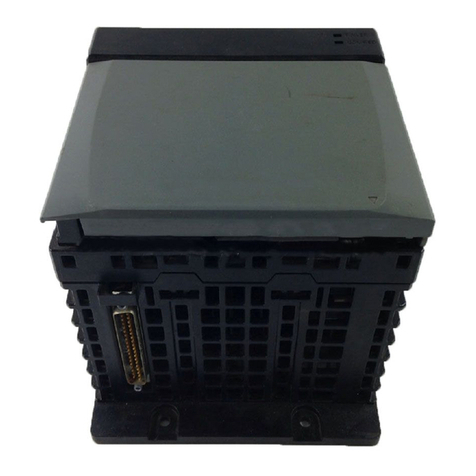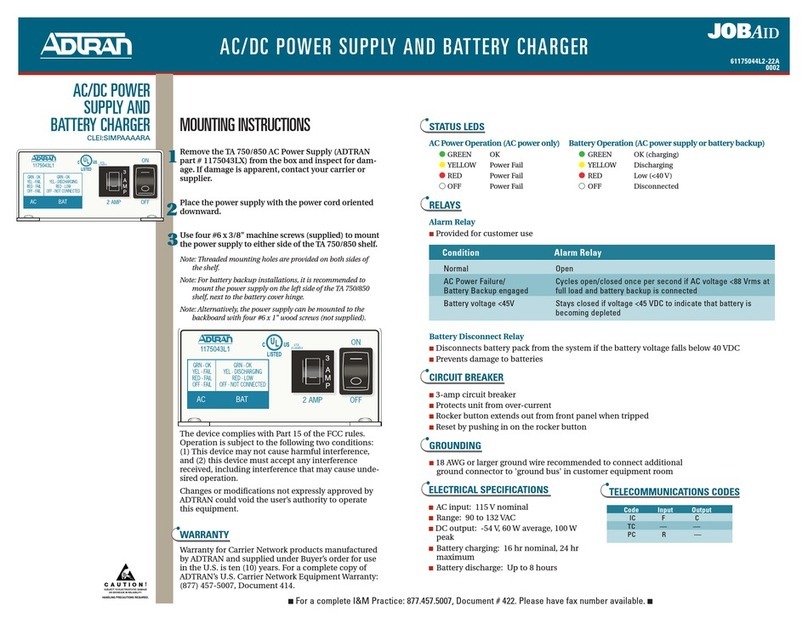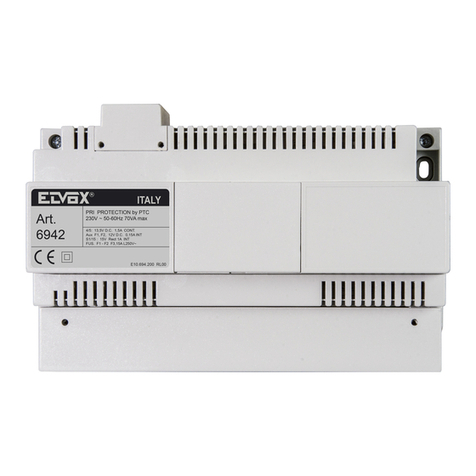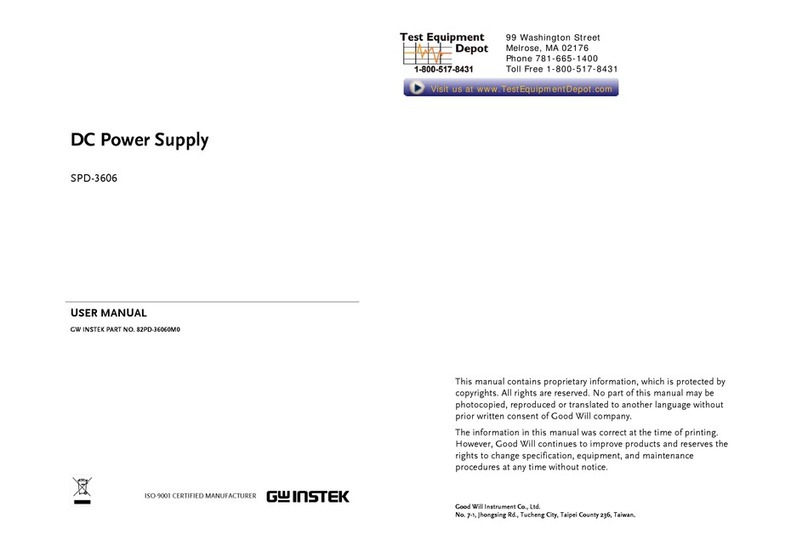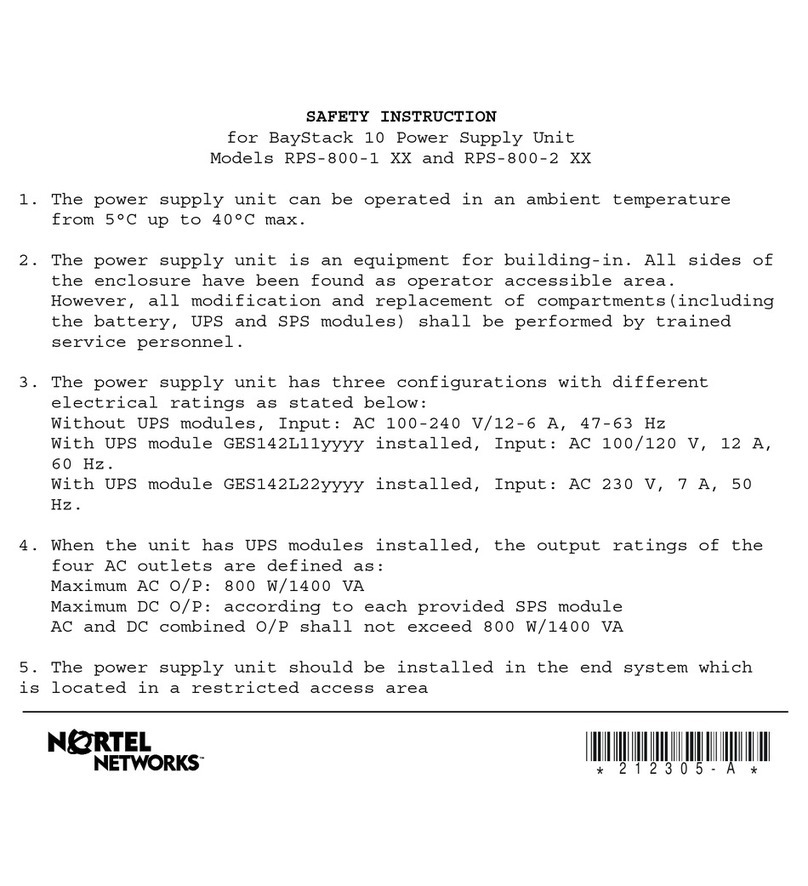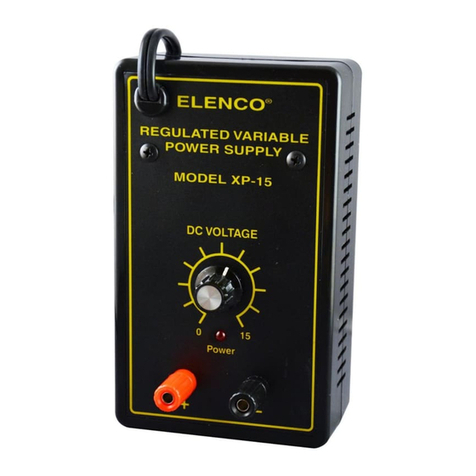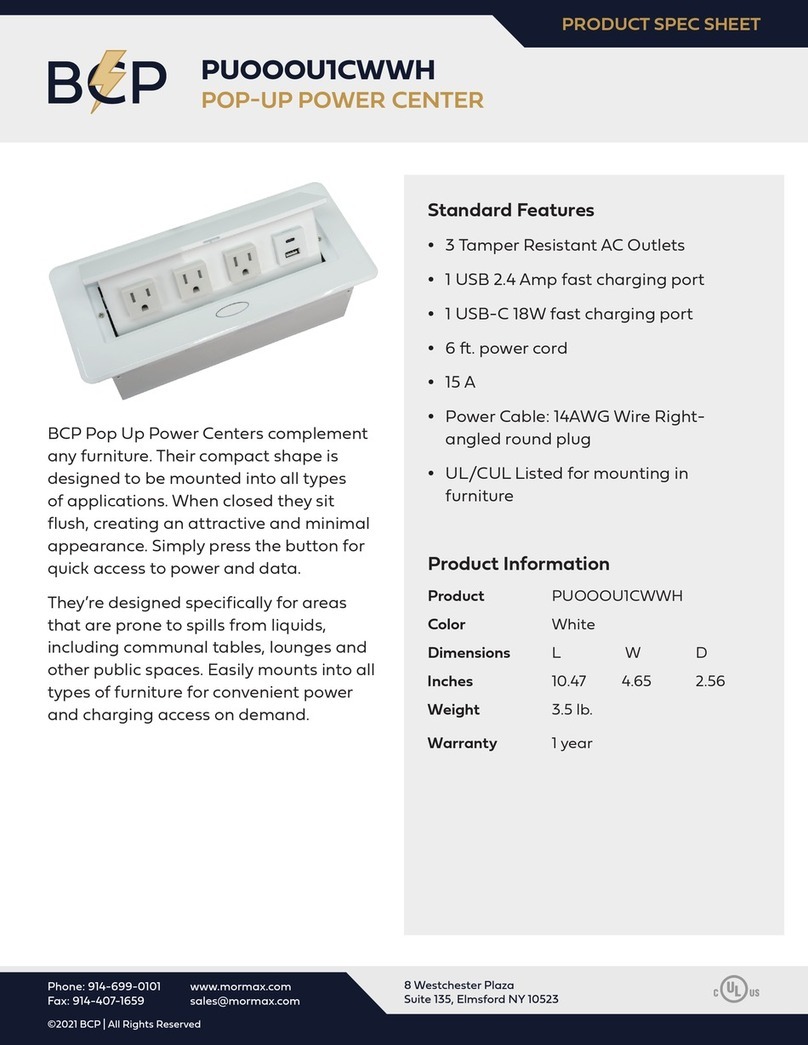DIGISYSTEM AFV2000 User manual

INSTRUCTION MANUAL
VARIABLE FREQUENCY VIBRATORS
POWER SUPPLY
AFV2000
ORDERING CODE
:
AP020201-APN20201-APS20201
filename: AP020201_eng
update: 09/11/2012

2
INDEX
INTRODUCTION ..........................................................................................................................................2
DEVICE DESCRIPTION ..............................................................................................................................3
TECHNICAL SPECIFICATIONS ................................................................................................................4
WIRING TABLE ............................................................................................................................................5
STARTUP .......................................................................................................................................................6
PROBLEMS SOLUTION ..............................................................................................................................7
OPENING INSTRUCTIONS.........................................................................................................................7
PARTS
IDENTIFICATION...........................................................................................................................8
OPTION'S WIRING TABLE.........................................................................................................................9
INTRODUCTION
The vibrators power supply has been designed to keep in vibration the feeded system giving it
the necessary energy exactly when required.
The most common application of this device is the feeding of the electro-magnets excitation
coils which are installed in the vibrating system, linear and circular, usually employed as feeding
devices in automation systems.
All the feeders traditionally used supply the load with a fixed frequency depending on power
mains.
As we have to fit the springset to the feeding frequency we don’t have satisfactory
results.
To approach as soon as possible the resonance condition, the manufacturer of this feeding
system is obliged to do many adjustments on the springset supporting the container of the pieces to
feed.
This complicated operation seldom reaches the resonance condition1.
Using the vibrators power supply, to change the feeding frequency in order to reach the
resonance condition, it is sufficient to regulate the 4 rotating switches placed on the front panel.
Having the possibility to adjust the feeding frequency to the springset the improvements
reached are immediately verifiable.
As the regulation above mentioned can be made while the system is in motion, in a few
minutes you can find the best feeding frequency and obtain from the system the best performances.
This device proved utility also after the first installation because as the springset change its
elasticity on the time in consequence of the enervation of the material.
It is possible to keep unchanged the system performances by the years.
1
RESONANCE CONDITION: It is the frequency by which the feeding system delivers the minimum energy to
obtain the maximum vibration: The system is composed by the springset and the container of the products to be
feeded.

3
DEVICE DESCRIPTION
Using a variable frequency power supply the optimisation of the vibrating system may result
very easy because the natural frequency of the controlled device can be easily tuned.
Because this tuning may be executed with system running, in few minutes the optimal
frequency may be found.
With reference to the drawing at the bottom of this manual, it will be very simple to identify
the most important components.
Two holes (diam. 6 mm) will allow to fix the box to the structure which will support the
device.
Electrical connections are made through fairleads plus terminals box (for power supply and
commands) and 4 poles connector (for vibrator).
The mains supply is disjointed by a breaker and is protected with fuses inside the box.
The vibration intensity may be regulated with the potentiometer (the minimum and maximum
limits of potentiometer may be regulated with trimmers MIN e MAX accessible on front panel).
The vibration frequency is selected through 4 rotating selectors located on front panel (the
most left digit are hundreds of Hz, the second are tens, the third are units and the most right are
tenths of Hz).
Overloads are limited electronically (with autoreset) and are signaled from a red led.
The power supply is shipped with autostart on power-on (switch SW2 on front panel = up)
and voltage reference from potentiometer on front panel (switch SW3 on front panel = up).

4
TECHNICAL SPECIFICATIONS
Power supply: 230Vac ± 15%, frequency 50 or 60 Hz
Output voltage: from 50 to 220Vca (with power supply 230Vca)
Output compensation: compensation of power supply variations
Output frequency: from 3,0 to 199,9 Hz in step of 0,1 Hz
Current: maximum current 5 Amperes peak (about 2,5 Arms) limited
from a circuit with autoreset
Fuses: 4 A fast action 250Vac; dimensions 5x20
Voltage output: soft-start with ramp of about 0,5 seconds
Remote commands: start/stop with external voltage PNP
(15 ÷ 30 Vdc, current 10 mA) optocoupled
external potentiometer see page 9
voltage reference 0 ÷ 5 Vdc see page 9
start/stop NPN see page 9
Mechanical protection: IP 50 (on request IP 54)
EMI Protection: meets following regulations: LVD CEI EN60439-1
EMC CEI EN50082-2
EMC CEI EN50081-2
If observed wiring instructions.
Wiring: fairlead and wire with shuko for mains input and HAN-3A
Harting connector for vibrator output.
Dimensions: 169 x 120 x 76 mm (height, breadth, depth)
(90 mm must be provided in low side for connector insertion)
Weight: 1,2 Kg

5
WIRING TABLE
PIN REF.
SIGNAL DESCRIPTION WIRE
SECTION
mmq
WIRE
COLOR
CONNECT TO:
PC1
M3-6
GROUND CONNECTION
3x1 YELLOW-GREEN EARTH
PC1
M3-5
MAINS INPUT (NEUTRAL)
3x1 BLUE or
WHITE
230 Vac
PC1
M3-4
MAINS INPUT (PHASE) 3x1 BROWN 230 Vac
D2-T GROUND CONNECTION
3x1
shielded
VIBRATOR
MECHANICAL
D2-1 OUTPU SUPPLY FOR VIBRATOR
3x1
shielded
VIBRATOR COIL
D2-2 OUTPU SUPPLY FOR VIBRATOR
3x1
shielded
VIBRATOR COIL
PC3
M2-4
0V INSULATED
0V
PC3
M2-3
START COMMAND INPUT
(required current 10 mA)
SENSOR OR
CONTACT
PC3
M2-1
+18V INSULATED
+18V
PC3
M2-2
OUTPUT INVERTER OK SIGNAL
(PNP)
PLC INPUT
Note: The guts of the vibrator must be grounded with a appropriate wire.
Before feeding the device verify that there are not ground dispersions on
wires connecting the power supply to the vibrator; The power supply will be
damaged if one of the two output wires is grounded.

6
STARTUP
•Verify that mains breaker I1 is in OFF position
•Put the potentiometer P3 at about 20%
•Verify switch SW2 (red) lever status (if is up the power supply will start as soon as
supplied, if is down the external start command is required)
•Verify switch SW3 (yellow) lever status (if is up the voltage reference is coming
from potentiometer, if is down the external voltage reference is required)
•Verify if the trimmer P1 (MIN)is rotated fully counterclockwise and if the trimmer
P2 (MAX) is rotated fully clockwise
•Verify that all connections are fastened
•Put rotating switches SW1 at 050.0 if a output frequency of 50.0 Hz is required
•Connect the mains (230 Vac) via PC1 cable (or schuko plug)
•Close mains switch I1; if start command is active the vibrator will be supplied at the
frequency selected with rotating switches SW1 (50 Hz) and at the voltage defined
from potentiometer P3.
In practice, the search of the resonance frequency is made by checking the effects on the
product feeding obtained by regulating the selectors SW1 values.
Usually the resonance frequency is not too far from the rated (for a 50 Hz vibrator should be
between 45 and 55 Hz), but also a little frequency change will determine a significant speed change.
Than, proceed by further guesses until you find the position of the rotating switches SW1
which determines the resonance condition.
Then, after having reached it increase (or decrease) the potentiometer value P3 to obtain the
required vibration level.
During the research stage it is suitable that the potentiometer P3 remains at 20% of the
end of scale.
If, increasing the potentiometer P3 value, the green led DL1 switches off whereas the red one
DL2 switches on and the vibrator stops, it means that the device is in overload; decrease the
potentiometer value and the power supply will automatically reset the overload condition.

7
PROBLEMS SOLUTION
fault functional
anomaly
What to do
Led DL2 switches regularly on and off Overload
condition
Rotate P3 counterclockwise to
decrease the output power
Switching on I1 the lamp L1 doesn't
switch on and DL2 lights momentary on
Lamp L1 failure
Substitute switch
Switching on I1 the lamp L1 doesn't
switch on and DL2 doesn't light at all
Device not
supplied
Verify mains supply and input
fuses; to locate fuses F1 see
instructions to open the device
Switching on I1 the lamp L1 switches
on, led DL1 is off and led DL2 switches
momentary on, but vibration doesn't
start
There is not
start command
Place switch SW2 to on or send
a external start command from
input cable
Switching on I1 the lamp L1 switches
on, led DL1 is on and led DL2 switches
momentary on, but vibration doesn't
start
Vibrator not
supplied
Check wiring from power
supply to vibrator; if the wiring
is correct there is probably a
failure on drivers into the power
supply
If actions remarked on the table doesn't resolve the problem you may contact factory
digisystem srl (e-mail
) we will help you.
OPENING INSTRUCTIONS
As on the electronic card there are some capacitors with high voltage applied (presence of
residuary energy, danger of strike) you must wait at least 4 - 5 minutes after the device is
disconnected from the power supply, before opening the box.
Switch I1 off and disconnect mains cable
Remove the knob (take the lid off and unlose the screw or nut), unlose the nut of the
potentiometer and the four screws X3 on the panel.

8
PARTS
IDENTIFICATION:
PART REF. FUNCTION
Fairlead PC1 Mains input 230Vac access to M3
Fairlead PC2 Load output access to M3
Fairlead PC3 Start-stop command access to M2
Breaker I1 Mains switch
Lamp L1 Mains lamp
Fuses F1 Mains fuses
Trimmer P1 Sets minimum reference voltage from potentiometer
Trimmer P2 Sets maximum reference voltage from potentiometer
Potentiometer 10K P3 Regolates output voltage
Rotary switches SW1 Selects output frequency
Switch SW2 Sets start command (autostart or external start command)
Switch SW3 Selects voltage reference for speed change from panel or external
Green led DL1 Power supply running (internal or external start command received)
Red led DL2 Power supply inhibited
Box X1 Anodized aluminum
Front panel X2 Anodized aluminum
Screws X3 Fastening front panel to the box
Lower bracket X4 Lower bracket anodized aluminum
Hole X5 Fixing box to wall
Upper bracket X6 Upper bracket anodized aluminum
bottom view
front view
mains input vibr. star/stop
169.0
remote
potentiometer

9
OPTIONS WIRING TABLE (M2)
REF.
SIGNAL DESCRIPTION
POT.
PLC
Wire mmq
M2
-
8
Voltage reference (0
-
5v)
Ref.(0÷5V)
0,5
M2
-
7
Potentiometer cursor
Cursor
0,5
M2
-
6
Potentiometer minimum
Ccw
0V Plc
0,5
M2
-
5
Poten
tiometer maximum
Cw
No connect.
0,5
M2
-
4
0V insulated for remote commands
0,5
M2
-
3
Remote start command (PNP or NPN)
0,5
M2
-
2
Output power supply OK (PNP)
0,5
M2
-
1
+18V insulated for remote commands
0,5
If voltage reference is coming from potentiometer 10K located on front panel, the
switch SW3 (yellow) must be ON (lever up);
The power supply is delivered with this switch on.
If voltage reference is coming from external voltage generator, the switch SW3 (yellow)
must be OFF (lever down) connect 0V at pin 6 and reference at pin 8.
If voltage reference is coming from external potentiometer 10K, the switch SW3
(yellow) must be OFF (lever down), the potentiometer sliding
contact must be connected to
pin 8, the CW to pin 5 and the CCW to pin 6.
A switch (SW2 red) on front panel selects automatic or remote start/stop; the switch
ON selects start at power-on, the switch OFF enables start from external command. The
power supply is delivered with this switch ON.
The start-stop control with one external sensor (photocell or other type of sensor) is
available a supply (18 V 50 mA not stabilized).
PNP Sensor: connect supply of sensor between pins 1 (
+18V
) and 4 (
0V
), connect signal of
sensor at pin 3.
NPN Sensor: connect supply of sensor between pins 1 (
+18V
) and 4 (
0V
), connect signal of
sensor at pin 3 and change position of jumper H4 from P to N; H4 is located inside the box,
see opening instructions.
Inverter OK: for remote check of the power supply is available a PNP (18V 20mA) signal
at pin 2; pin 4 is 0V.
Other manuals for AFV2000
1
This manual suits for next models
3
Table of contents
Other DIGISYSTEM Power Supply manuals
Popular Power Supply manuals by other brands
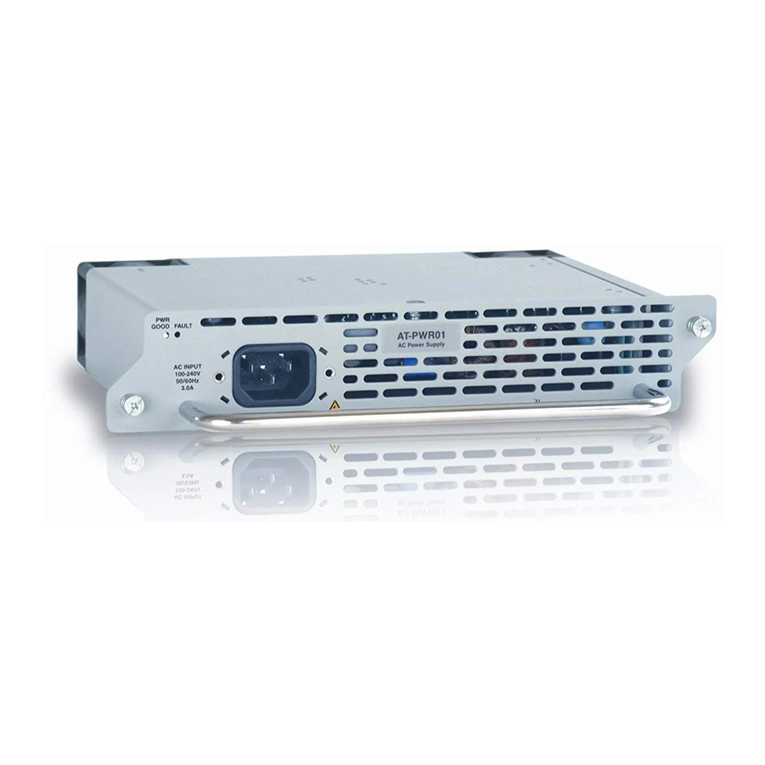
Allied Telesis
Allied Telesis AT-PWR01 Quick install guide
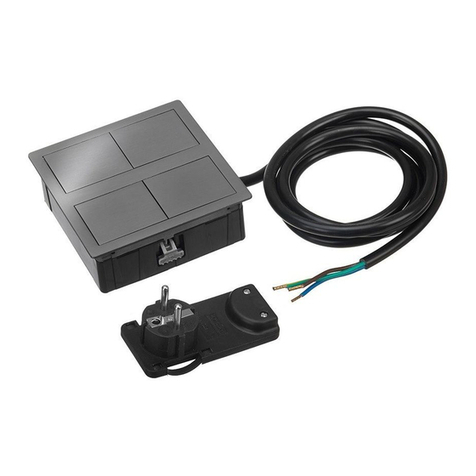
ASA Electronics
ASA Electronics VersaLogic VersaHIT Dual Manual instructions

MFJ Enterprises
MFJ Enterprises MIGHTYLITE MFJ-4125 instruction manual

NCR
NCR 7761-K120 Kit instructions
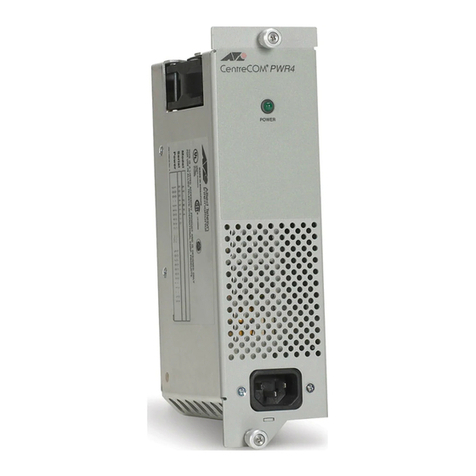
Allied Telesis
Allied Telesis AT-PWR4 installation guide
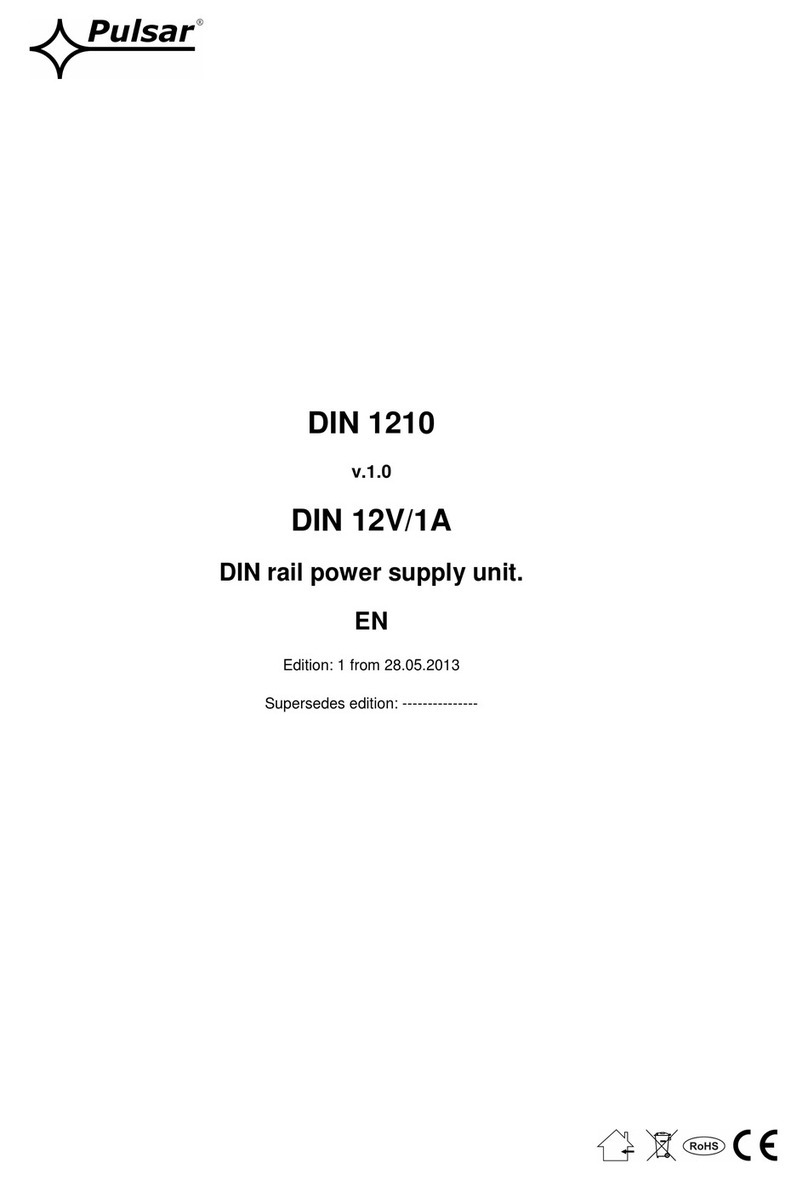
Pulsar
Pulsar DIN 1210 manual
